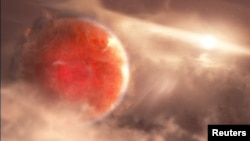Scientists have recently observed a large planet at an early stage of formation. The planet is already nine times the mass of Jupiter.
The researchers used the Subaru Telescope in Hawaii and the Hubble Space Telescope to find and study the planet. It is a gas giant orbiting an unusually far away young star. Gas giants are planets, like our solar system's Jupiter and Saturn. They are made up of hydrogen and helium. Those gases surround a smaller solid core, the innermost part of a planet.
"We think it is still very early on in its 'birthing' process," said astrophysicist Thayne Currie of the Subaru Telescope and the NASA-Ames Research Center. He is the lead writer of the study that appeared recently in the publication Nature Astronomy. "Evidence suggests that this is the earliest stage of formation ever observed for a gas giant," he added.
The planet surrounds a star called AB Aurigae, about 9.5 trillion kilometers from Earth. An image of the star appeared in the 2021 film "Don't Look Up."
About 5,000 planets beyond our solar system, or exoplanets, have been identified. This one, called AB Aur b, is among the largest.
Planets in the process of formation - called protoplanets - have been observed around only one other star.
Almost all known exoplanets have orbits around their stars within the distance that separates our sun and its most faraway planet, Neptune. But this planet orbits three times as far as Neptune from the sun and 93 times Earth's distance from the sun.
Its formation appears to be following a different process than the way planets usually form.
Olivier Guyon is an astronomer with the Subaru Telescope and the University of Arizona. He is a co-writer of the planet study. Guyon said the usual thinking is that most planets form by the slow growth of solids onto a rocky core. He noted that gas giants go through this process before the solid core is large enough to start layering gases.
In this situation, protoplanets in the area surrounding a young star slowly grow out of dust- to large rock-sized solid objects. If this core reaches several times Earth's mass, they begin gathering gas from the surrounding dust and gas.
"This process cannot form giant planets at large orbital distance, so this discovery challenges our understanding of planet formation," Guyon said.
The researchers believe AB Aur b is forming in a situation in which the area around the star cools. Gravity then causes it to break up into one or more huge masses that form into planets.
The star AB Aurigae is about 2.4 times bigger than our sun and almost 60 times brighter. It is about 2 million years old -- very young compared to our 4.5-billion-year-old sun.
"New astronomical observations continuously challenge our current theories, ultimately improving our understanding of the universe," Guyon said.
He added, "Planet formation is very complex and messy, with many surprises still ahead."
I’m Jonathan Evans.
Will Dunham reported on this story for the Reuters news service. Jonathan Evans adapted this story for Learning English.
____________________________________________________
Words in This Story
layer – v. to form or arrange one thickness of something over another
challenge – n. a difficult task or problem
messy – adj. not clean or tidy








